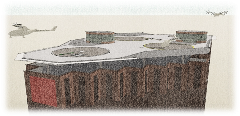eVTOL Infrastructure Considerations for Advanced Air Mobility

- Providing the latest information and data for vertiport & heliport design considerations
- Differentiating aviation reality from marketing hype and animated fiction
- All students will receive an AIAA Certificate of Completion at the end of the course
OVERVIEW
The eVTOL industry is moving at a rapid pace with numerous aircraft currently in the process of certification. While some see the first eVTOL aircraft being potentially certified within the next two to three years, these unique modes of transportation will still need a suitable and safe place to take off and land. This course will provide a basic understanding of what vertical lift infrastructure is and what key elements need to be considered as well as provide an overview of some of the more technical aspects that must be considered.
LEARNING OBJECTIVES
- Identify commonly used terminology for defining and describing infrastructure.
- Calculate infrastructure dimensions necessary to support vertical lift operations.
- Understand the basics of airspace design to support vertical lift infrastructure.
- Gain an up-to-date understanding of the latest developments in infrastructure standards
- .Identify aircraft performance criteria to consider for infrastructure design.
- Understand the influence urban environments have on infrastructure design and safety.
- Review factors shown to perpetuate infrastructure accidents.
- [See detailed course outline below]
WHO SHOULD ATTEND
This course is designed for those interested in learning what it will take to develop eVTOL and powered lift infrastructure that is feasible, economical, and safe, that is accessible to all, and that is assured longevity. Participants will be provided the key building blocks of vertical lift infrastructure design, development and safety in conjunction with an emphasis on strategic aspects specific to complexed urban environments. As such, this course has been developed for both individuals who have little experience in vertical lift infrastructure as well as those who may have a significant level of knowledge on the subject.
This course is also available on-demand. (Sign-In To Register)
CLASSROOM HOURS / CEUs: 8 classroom hours / 0.8 CEU/PDH
Outline
COURSE OUTLINE
CLASS 1
CLASS 1
- Applicable Regulations for infrastructure design and regulatory compliance
- Building Codes that apply to infrastructure design and safety
- Fire Codes that apply to infrastructure design and safety
- Applicable FAA Advisory Circulars for infrastructure design and development
- Infrastructure Terminology
- The importance of developing the correct “Design Aircraft
- ”Calculating minimum infrastructure geometry
- Performance vs prescriptive methodologies in infrastructure design
- Future proofing infrastructure design
CLASS 2
- Infrastructure airspace access considerations
- Approach/Departure airspace geometry
- Airspace obstruction and hazard determination and calculations
- In flight human physiology and G-loading tolerance
- Calculating landing surface point loading
- Calculating rotor downwash velocity and impact
- Aircraft certification and performance considerations
- In Ground Effect Power vs Out of Ground Effect Power
- Elevated infrastructure
CLASS 3
- Developing historical wind data for site selection and airspace
- Considering aerodynamic deficiencies in site selection and design
- Turbulence modeling in a wind tunnel
- Flight testing for infrastructure validation
- Architecturally induced turbulence
- Rotor wake interaction with structures
- Wind turbine considerations for vertiport site selection
- Considering electromagnetic Interference at infrastructure
CLASS 4
- Infrastructure accident statistics
- Infrastructure accident case studies
- Inadequate infrastructure geometry
- Obstruction encroachment
- Insufficient aircraft performance
- Inadequate infrastructure airspace
- Deficiencies in turbulence mitigation
Materials
Instructors
Rex Alexander has over four decades of military aviation, general aviation, and commercial aviation experience, and is a globally recognized subject matter expert on helicopter, powered lift and eVTOL infrastructure. He is the founder and president of the aeronautical consulting firm Five-Alpha LLC (5α) and serves as Infrastructure Advisor to the Vertical Flight Society.
He is co-chair of the US Helicopter Safety Team (USHST) Infrastructure Working Group, Chair of the National Fire Protection Association (NFPA) 418, Standard for Heliports, a member of ASTM International F38 WK59317 New Specification for Vertiport Design, a member of the Vertical Aviation Safety Team (VAST) Technology Working Group, a member of the Illuminating Engineering Society (IES) Aviation Lighting Committee, and a member of the Helicopter Association International (HAI) Vertical Flight Infrastructure Sub-Working Group.
Mr. Alexander serves as a platform instructor to the U.S. Department of Transportation's (DOT) Transportation Safety Institute (TSI) for their Heliport Evaluation Course and Advanced Helicopter Accident Investigation Course. He holds a Bachelor of Science in Aviation Maintenance and Management from Parks College of Aviation and Aerospace Technology and is a former US Army Warrant Officer and ‘Aeroscout’ Helicopter Pilot, Instructor Pilot and Standardization Instructor, having served both on active duty and in the Indiana Army National Guard.
AIAA Training Links
For information, group discounts,
and private course pricing, contact:
Lisa Le, Education Specialist (lisal@aiaa.org)
